八年级上册 Unit 8 How do you make a banana milk shake Section A1a3c课件+嵌入音频(共25张PPT)
文档属性
| 名称 | 八年级上册 Unit 8 How do you make a banana milk shake Section A1a3c课件+嵌入音频(共25张PPT) |  | |
| 格式 | pptx | ||
| 文件大小 | 64.4MB | ||
| 资源类型 | 教案 | ||
| 版本资源 | 人教新目标(Go for it)版 | ||
| 科目 | 英语 | ||
| 更新时间 | 2022-12-23 19:46:49 | ||
图片预览

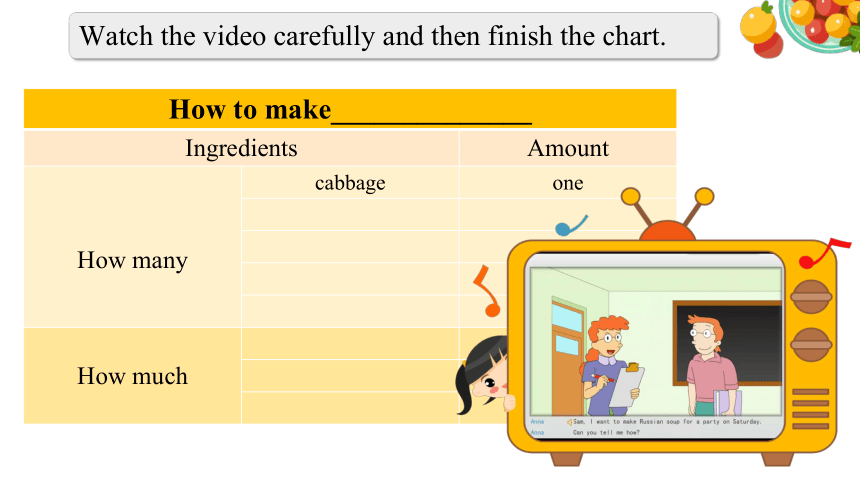
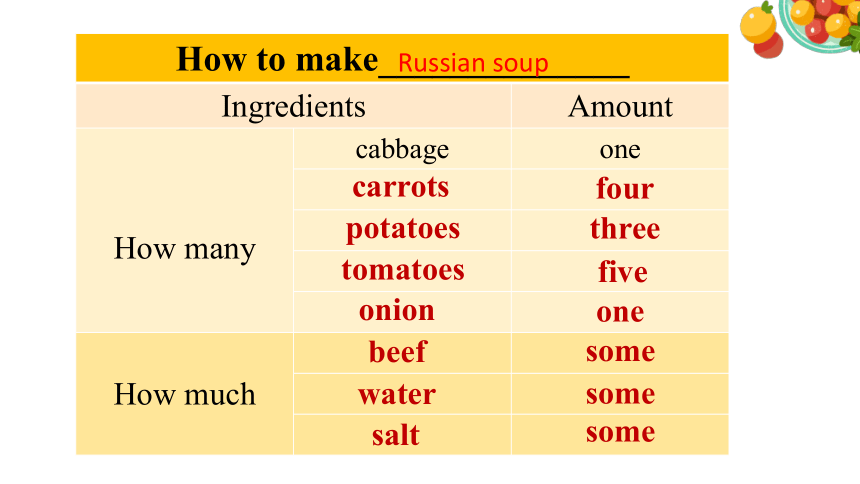
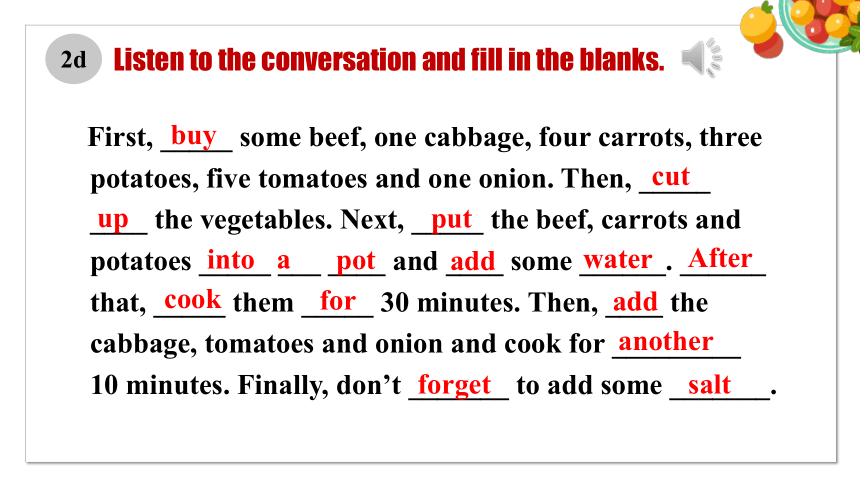
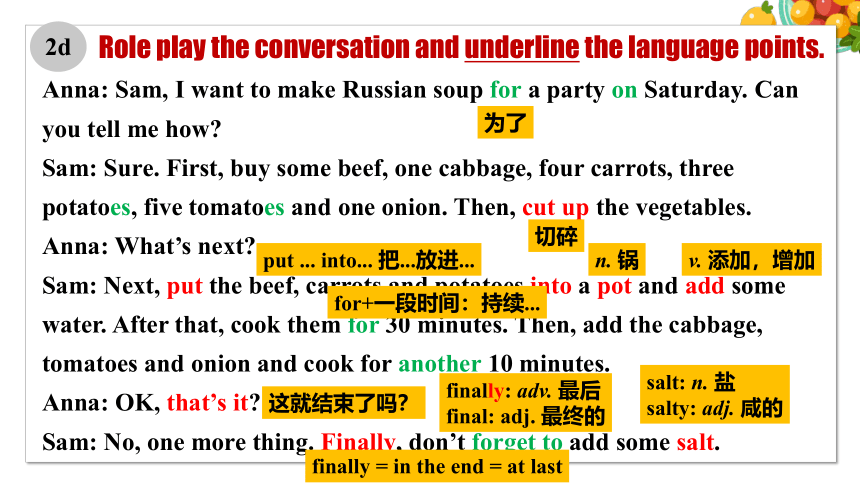
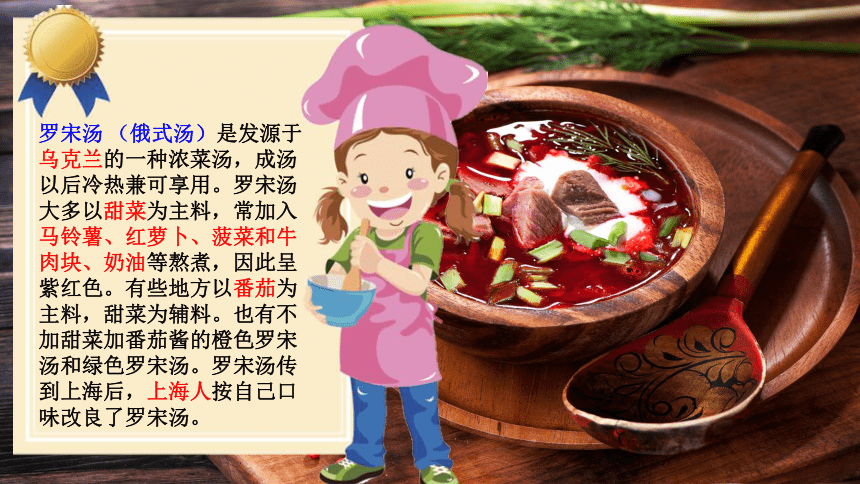
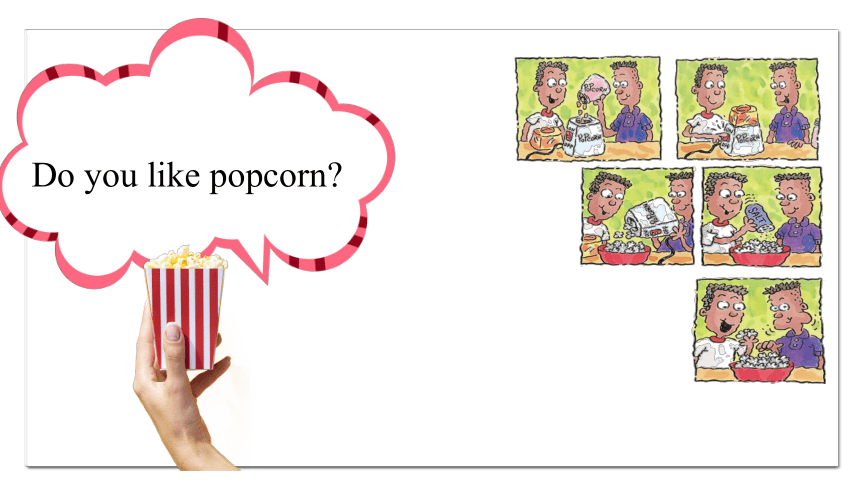
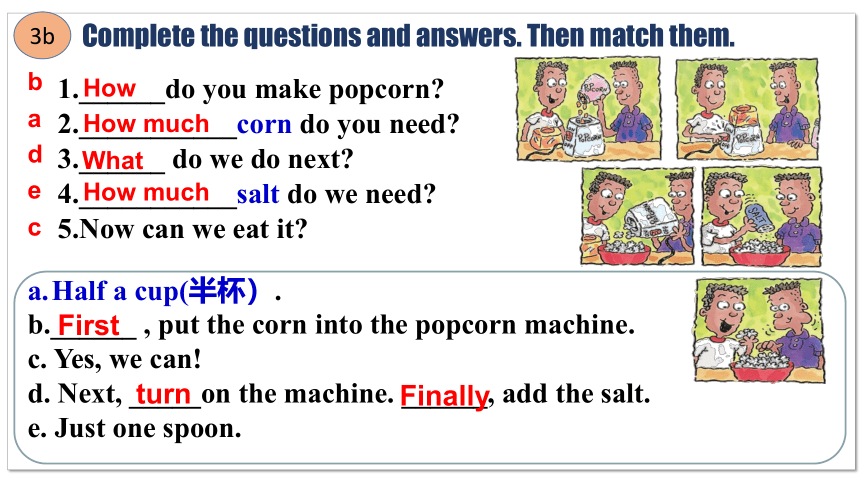
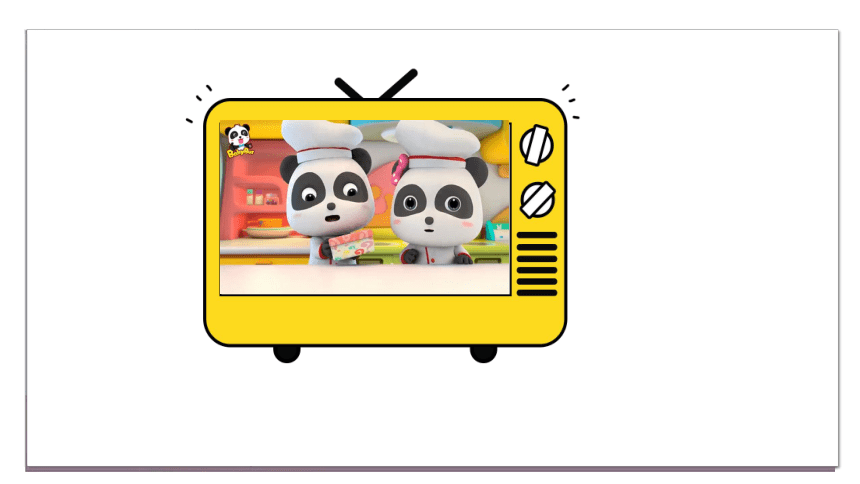
文档简介
(共25张PPT)
Section A GF-3c
Unit 8
How do you make a banana milk shake
Watch the video carefully and then finish the chart.
How to make______________ Ingredients Amount
How many cabbage one
How much
How to make______________ Ingredients Amount
How many cabbage one
How much
Russian soup
onion
carrots
potatoes
tomatoes
four
three
five
one
beef
water
salt
some
some
some
2d
Listen to the conversation and fill in the blanks.
First, _____ some beef, one cabbage, four carrots, three potatoes, five tomatoes and one onion. Then, _____ ____ the vegetables. Next, _____ the beef, carrots and potatoes _____ ___ ____ and ____ some ______. ______ that, _____ them _____ 30 minutes. Then, ____ the cabbage, tomatoes and onion and cook for _________ 10 minutes. Finally, don’t _______ to add some _______.
water
After
buy
cut
put
into a
add
up
pot
salt
cook
for
add
another
forget
Anna: Sam, I want to make Russian soup for a party on Saturday. Can you tell me how
Sam: Sure. First, buy some beef, one cabbage, four carrots, three potatoes, five tomatoes and one onion. Then, cut up the vegetables.
Anna: What’s next
Sam: Next, put the beef, carrots and potatoes into a pot and add some water. After that, cook them for 30 minutes. Then, add the cabbage, tomatoes and onion and cook for another 10 minutes.
Anna: OK, that’s it
Sam: No, one more thing. Finally, don’t forget to add some salt.
为了
切碎
put ... into... 把...放进...
n. 锅
v. 添加,增加
for+一段时间:持续...
这就结束了吗?
finally: adv. 最后
final: adj. 最终的
salt: n. 盐
salty: adj. 咸的
finally = in the end = at last
2d
Role play the conversation and underline the language points.
罗宋汤 (俄式汤)是发源于乌克兰的一种浓菜汤,成汤以后冷热兼可享用。罗宋汤大多以甜菜为主料,常加入马铃薯、红萝卜、菠菜和牛肉块、奶油等熬煮,因此呈紫红色。有些地方以番茄为主料,甜菜为辅料。也有不加甜菜加番茄酱的橙色罗宋汤和绿色罗宋汤。罗宋汤传到上海后,上海人按自己口味改良了罗宋汤。
Do you like popcorn
Half a cup(半杯).
b.______ , put the corn into the popcorn machine.
c. Yes, we can!
d. Next, _____on the machine. ______, add the salt.
e. Just one spoon.
1.______do you make popcorn
2.___________corn do you need
3.______ do we do next
4.___________salt do we need
5.Now can we eat it
How
How much
What
How much
First
turn
Finally
b
a
d
e
c
Complete the questions and answers. Then match them.
3b
How do you make popcorn
First, add some butter.
Then, put the kernels.
Then, fry and fry...
How do you make popcorn
Next, cover the pot.
Finally, eat it.
Then, add the salt.
First, add some butter.
Then, put the kernels.
Then, fry and fry...
Next, cover the pot.
Finally, eat it.
Then, add the salt.
imperative sentences 祈使句
用以表示请求、命令、许可、劝告、建议、禁止
通常以动词原形或Don’t +动词原形开头
没有时态和数的变化;
暗含的主语是you, 但通常省略。
1. 以实义动词原形开头。
e.g. Come here.
Look at the map.
2. 以动词be开头。
e.g. Be a good boy.
Be quiet, please.
3. 以Let开头。
e.g. Let me have a look.
Let’s go!
有时可在祈使句的句首或句尾加上please,使语气显得客气、有礼貌。如果在句尾加please,应该用逗号与前句隔开。
e.g. Come in, please.
肯定式
No + 名词 /
动词-ing形式”表示禁止或规劝,常用于公共场所。
e.g. No photos!
No smoking!
否定式
4. 在动词原形前加don’t。
e.g. Don’t sit here.
Don’t be late.
5. 以No开头的祈使句。
eg. No photos.
No smoking.
1. ______ the milk______ the blender. (把···倒入)
2. ______the bananas. (剥皮)
3. ______ quiet! (保持安静)
4. _______careful! (小心点)
5. ________make a banana milk shake together.(让我们)
6. _______ him_______go out.(不要让他出去)
7. _______photos! (禁止拍照)
8.________smoking! (禁止吸烟)
9. _____ be late.(不要迟到)
10. _____ eat in class!(上课不要吃东西)
Try to fill in the blanks.
Pour into
Peel
Be
Let's
Let not
No
No
Do型
Be型
Let型
No型
Be
Don’t
Don’t
Don’t型
Countable nouns Uncountable nouns
How many bananas do we need How much yogurt do we need
We need three bananas. We need one cup of yogurt.
how many/ much用来提问数量
how many 提问_____________数量
how much 提问_____________数量
可数名词(c.n.)
不可数名词(u.c.n)
how much 除了提问不可数名词数量,还用来提问价格
Grammar Focus
可数名词复数规则变化
(1)一般的名词变复数, 直接在词尾加-s。
book------books ,cup-----cups
(3)以辅音字母+y结尾的,先变y为i再加es
city-------cities ,family-----families
(2)以s、x、sh、ch结尾的加es
bus-----buses ,wish------wishes
元音字母+y,直接+s
boy----boys
Countable nouns
英雄爱吃西红柿和土豆
妻子拿刀去砍狼,小偷看到发了慌,躲在架下保己命,半片树叶遮目光
wife knife wolf thief shelf self half leaf
(4)以o 结尾有生命的物质的名词, 加-es
tomato-----tomatoes,potato------potatoes
hero-----heroes
(5)以o 结尾无生命的物质的名词, 加-s
zoo-----zoos,video------videos , radio-----radios
(6)以f或fe 结尾的,先把f、fe变成v再加es
如:leaf----leaves,self---selves,life----lives,thief---thieves
可数名词复数不规则变化
(1) 元音或词尾发生变化:
child--_________, mouse-- _________,
man--________, woman--_________,
foot--_________, tooth--_________, goose--_________
policeman--___________, Frenchman--_________
Englishman--_________
children
mice
men
women
feet
teeth
geese
policemen
Frenchmen
Englishmen
男士(man)、女士(woman)a变e;
鹅(goose)牙(tooth)脚(foot)双o变双e;
孩子(child)原形后面加ren
可数名词复数不规则变化
(2) 单复数同形
中(Chinese)日(Japanese)警察(police)好友(people)来聚会,鹿(deep)、羊(sheep)、鱼(fish)、牛(cattle)齐齐把家回
deer---deer fish----fish sheep----sheep
Chinese ----Chinese Japanese---Japanese
yuan---yuan
Tip: glasses, shoes, socks, trousers, gloves等名词往往用复数形式,故谓语用复数。
The trousers are very cheap and I want to take them.
不可数名词指不可以直接计数的名词,它只有单数形式。
Uncountable nouns
液体气体:water, tea,coffee,air
无固定形式,易融化: butter, cheese,
ice, soap
抽象名词:sadness,happiness
其他:rice, bread
不可数名词可数化
基数词+计量单位+of+不可数名词:
a
(two)
cup (cups)
piece(pieces)
bottle(bottles)
glasse(galsses)
...
coffee
bread
milk
orange
of
可数名词 不可数名词
修饰词 a/an,具体数词以及many, few, a few, fewer,more,some, any, a lot of, lots of等 much, little, a little, less, more,some, any, a lot of, lots of等以及表示量的短语(a cup/ glass of)
作主语 单数形式作主语,谓语动词用单数形式;复数形式作主语,谓语动词用复数形式
谓语动词用单数形式
1. How (much/many) bananas do we need
2. How (much/many) sugar do we need
3. How (much/many) bread do we need
4. How (much/many) tomatoes do we need
5. How (much/many) cheese do we need
Circle the correct word in each question.
3a
3c
Write how to do one of the following things. Then tell your partner how to do it.
plant a tree
make beef noodles
wash clothes
take out a book from the library
Do you know how to plant a tree
First, dig a hole. Then …
take out sth. from ...
从...拿出
Section A GF-3c
Unit 8
How do you make a banana milk shake
Watch the video carefully and then finish the chart.
How to make______________ Ingredients Amount
How many cabbage one
How much
How to make______________ Ingredients Amount
How many cabbage one
How much
Russian soup
onion
carrots
potatoes
tomatoes
four
three
five
one
beef
water
salt
some
some
some
2d
Listen to the conversation and fill in the blanks.
First, _____ some beef, one cabbage, four carrots, three potatoes, five tomatoes and one onion. Then, _____ ____ the vegetables. Next, _____ the beef, carrots and potatoes _____ ___ ____ and ____ some ______. ______ that, _____ them _____ 30 minutes. Then, ____ the cabbage, tomatoes and onion and cook for _________ 10 minutes. Finally, don’t _______ to add some _______.
water
After
buy
cut
put
into a
add
up
pot
salt
cook
for
add
another
forget
Anna: Sam, I want to make Russian soup for a party on Saturday. Can you tell me how
Sam: Sure. First, buy some beef, one cabbage, four carrots, three potatoes, five tomatoes and one onion. Then, cut up the vegetables.
Anna: What’s next
Sam: Next, put the beef, carrots and potatoes into a pot and add some water. After that, cook them for 30 minutes. Then, add the cabbage, tomatoes and onion and cook for another 10 minutes.
Anna: OK, that’s it
Sam: No, one more thing. Finally, don’t forget to add some salt.
为了
切碎
put ... into... 把...放进...
n. 锅
v. 添加,增加
for+一段时间:持续...
这就结束了吗?
finally: adv. 最后
final: adj. 最终的
salt: n. 盐
salty: adj. 咸的
finally = in the end = at last
2d
Role play the conversation and underline the language points.
罗宋汤 (俄式汤)是发源于乌克兰的一种浓菜汤,成汤以后冷热兼可享用。罗宋汤大多以甜菜为主料,常加入马铃薯、红萝卜、菠菜和牛肉块、奶油等熬煮,因此呈紫红色。有些地方以番茄为主料,甜菜为辅料。也有不加甜菜加番茄酱的橙色罗宋汤和绿色罗宋汤。罗宋汤传到上海后,上海人按自己口味改良了罗宋汤。
Do you like popcorn
Half a cup(半杯).
b.______ , put the corn into the popcorn machine.
c. Yes, we can!
d. Next, _____on the machine. ______, add the salt.
e. Just one spoon.
1.______do you make popcorn
2.___________corn do you need
3.______ do we do next
4.___________salt do we need
5.Now can we eat it
How
How much
What
How much
First
turn
Finally
b
a
d
e
c
Complete the questions and answers. Then match them.
3b
How do you make popcorn
First, add some butter.
Then, put the kernels.
Then, fry and fry...
How do you make popcorn
Next, cover the pot.
Finally, eat it.
Then, add the salt.
First, add some butter.
Then, put the kernels.
Then, fry and fry...
Next, cover the pot.
Finally, eat it.
Then, add the salt.
imperative sentences 祈使句
用以表示请求、命令、许可、劝告、建议、禁止
通常以动词原形或Don’t +动词原形开头
没有时态和数的变化;
暗含的主语是you, 但通常省略。
1. 以实义动词原形开头。
e.g. Come here.
Look at the map.
2. 以动词be开头。
e.g. Be a good boy.
Be quiet, please.
3. 以Let开头。
e.g. Let me have a look.
Let’s go!
有时可在祈使句的句首或句尾加上please,使语气显得客气、有礼貌。如果在句尾加please,应该用逗号与前句隔开。
e.g. Come in, please.
肯定式
No + 名词 /
动词-ing形式”表示禁止或规劝,常用于公共场所。
e.g. No photos!
No smoking!
否定式
4. 在动词原形前加don’t。
e.g. Don’t sit here.
Don’t be late.
5. 以No开头的祈使句。
eg. No photos.
No smoking.
1. ______ the milk______ the blender. (把···倒入)
2. ______the bananas. (剥皮)
3. ______ quiet! (保持安静)
4. _______careful! (小心点)
5. ________make a banana milk shake together.(让我们)
6. _______ him_______go out.(不要让他出去)
7. _______photos! (禁止拍照)
8.________smoking! (禁止吸烟)
9. _____ be late.(不要迟到)
10. _____ eat in class!(上课不要吃东西)
Try to fill in the blanks.
Pour into
Peel
Be
Let's
Let not
No
No
Do型
Be型
Let型
No型
Be
Don’t
Don’t
Don’t型
Countable nouns Uncountable nouns
How many bananas do we need How much yogurt do we need
We need three bananas. We need one cup of yogurt.
how many/ much用来提问数量
how many 提问_____________数量
how much 提问_____________数量
可数名词(c.n.)
不可数名词(u.c.n)
how much 除了提问不可数名词数量,还用来提问价格
Grammar Focus
可数名词复数规则变化
(1)一般的名词变复数, 直接在词尾加-s。
book------books ,cup-----cups
(3)以辅音字母+y结尾的,先变y为i再加es
city-------cities ,family-----families
(2)以s、x、sh、ch结尾的加es
bus-----buses ,wish------wishes
元音字母+y,直接+s
boy----boys
Countable nouns
英雄爱吃西红柿和土豆
妻子拿刀去砍狼,小偷看到发了慌,躲在架下保己命,半片树叶遮目光
wife knife wolf thief shelf self half leaf
(4)以o 结尾有生命的物质的名词, 加-es
tomato-----tomatoes,potato------potatoes
hero-----heroes
(5)以o 结尾无生命的物质的名词, 加-s
zoo-----zoos,video------videos , radio-----radios
(6)以f或fe 结尾的,先把f、fe变成v再加es
如:leaf----leaves,self---selves,life----lives,thief---thieves
可数名词复数不规则变化
(1) 元音或词尾发生变化:
child--_________, mouse-- _________,
man--________, woman--_________,
foot--_________, tooth--_________, goose--_________
policeman--___________, Frenchman--_________
Englishman--_________
children
mice
men
women
feet
teeth
geese
policemen
Frenchmen
Englishmen
男士(man)、女士(woman)a变e;
鹅(goose)牙(tooth)脚(foot)双o变双e;
孩子(child)原形后面加ren
可数名词复数不规则变化
(2) 单复数同形
中(Chinese)日(Japanese)警察(police)好友(people)来聚会,鹿(deep)、羊(sheep)、鱼(fish)、牛(cattle)齐齐把家回
deer---deer fish----fish sheep----sheep
Chinese ----Chinese Japanese---Japanese
yuan---yuan
Tip: glasses, shoes, socks, trousers, gloves等名词往往用复数形式,故谓语用复数。
The trousers are very cheap and I want to take them.
不可数名词指不可以直接计数的名词,它只有单数形式。
Uncountable nouns
液体气体:water, tea,coffee,air
无固定形式,易融化: butter, cheese,
ice, soap
抽象名词:sadness,happiness
其他:rice, bread
不可数名词可数化
基数词+计量单位+of+不可数名词:
a
(two)
cup (cups)
piece(pieces)
bottle(bottles)
glasse(galsses)
...
coffee
bread
milk
orange
of
可数名词 不可数名词
修饰词 a/an,具体数词以及many, few, a few, fewer,more,some, any, a lot of, lots of等 much, little, a little, less, more,some, any, a lot of, lots of等以及表示量的短语(a cup/ glass of)
作主语 单数形式作主语,谓语动词用单数形式;复数形式作主语,谓语动词用复数形式
谓语动词用单数形式
1. How (much/many) bananas do we need
2. How (much/many) sugar do we need
3. How (much/many) bread do we need
4. How (much/many) tomatoes do we need
5. How (much/many) cheese do we need
Circle the correct word in each question.
3a
3c
Write how to do one of the following things. Then tell your partner how to do it.
plant a tree
make beef noodles
wash clothes
take out a book from the library
Do you know how to plant a tree
First, dig a hole. Then …
take out sth. from ...
从...拿出
同课章节目录
- Unit 1 Where did you go on vacation?
- Section A
- Section B
- Unit 2 How often do you exercise?
- Section A
- Section B
- Unit 3 I'm more outgoing than my sister.
- Section A
- Section B
- Unit 4 What's the best movie theater?
- Section A
- Section B
- Unit 5 Do you want to watch a game show?
- Section A
- Section B
- Unit 6 I'm going to study computer science.
- Section A
- Section B
- Unit 7 Will people have robots?
- Section A
- Section B
- Unit 8 How do you make a banana milk shake?
- Section A
- Section B
- Unit 9 Can you come to my party?
- Section A
- Section B
- Unit 10 If you go to the party, you'll have a grea
- Section A
- Section B
